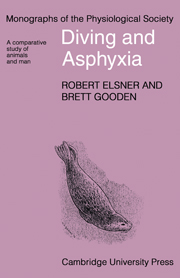5 - Control mechanisms
Published online by Cambridge University Press: 18 May 2010
Summary
A living system is no more adequately characterized by an inventory of its material constituents … than the life of a city is described by the list of names and numbers in a telephone book. Only by virtue of their ordered interactions do molecules become partners in the living process …
(Paul A. Weiss, 1969).The rapid onset of respiratory and cardiovascular responses to diving and face immersion argues for their initiation by neural control mechanisms. Questions concerning these regulatory pathways have been subjected to study beginning with observations on diving ducks a century ago and continuing to the present day. It is possible to trace during this period four main lines of research into suspected reflexes which have led to the current state of understanding, often by routes in which the study of diving was not the primary motivation. These lines of research have involved reflexes originating from (1) receptors situated in the face, nasal mucosa and pharynx, (2) thoracic and pulmonary receptors, (3) peripheral arterial chemoreceptors and (4) arterial baroreceptors. More recently, the important role of the interactions of various respiratory and circulatory reflexes has come to be recognized.
Historically, much research into the nature of cardiovascular reflexes has depended upon experiments in which a discrete and isolated subsystem is stimulated and the unmodulated or passive output is recorded. The input of such an ‘open-loop’ reflex is independent of, and unaffected by, its output; it is deprived of feedback.
- Type
- Chapter
- Information
- Diving and AsphyxiaA Comparative Study of Animals and Man, pp. 74 - 103Publisher: Cambridge University PressPrint publication year: 1983



